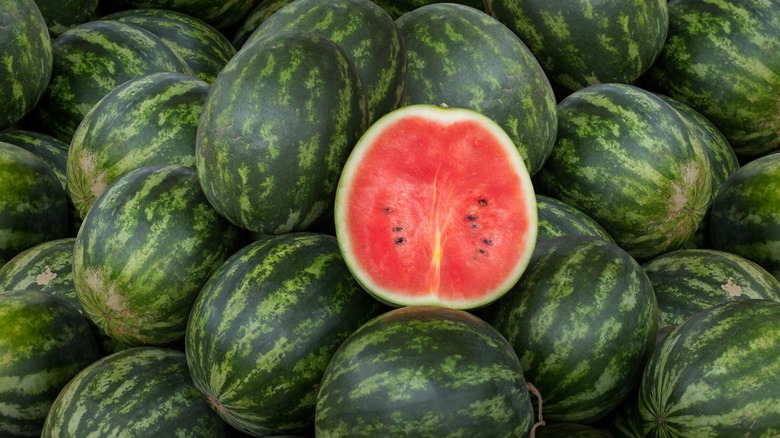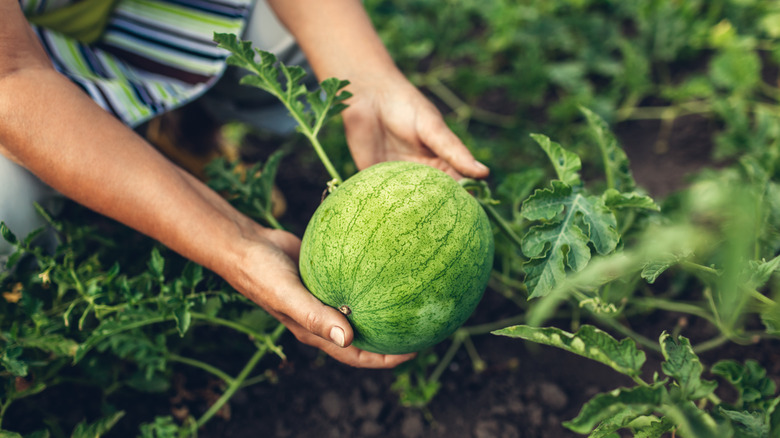Why Syrup Spots On Watermelon Are A Good Sign
The usual way to pick fresh produce at a grocery store is to look for the smoothest and shiniest fruits and veggies in the rack while generally staying away from anything that has blemishes, dark spots, or looks a tad dull. Blueberries should have a frosty sheen, for example, whereas cucumbers shouldn't have any signs of yellow discoloration. Lemons, limes, and eggplants should have smooth and glossy skins, and quinces and tomatoes should be free of spots and blemishes. However, when it comes to sweet and juicy watermelons, the rules of fruit picking are a little different.
Nothing will put a damper on the mood quite like slicing open a sparkling, blemish-free watermelon on a scorching hot day only to find that it is flat, flavorless, and far from the sugary sweet that it should be. Sadly, the most perfect-looking watermelons aren't always the best. On the contrary, the best watermelons have large patches of webbing or even small spots that look like dirt on them.
Often known as sugar spots, these dots are pollination points from where sugar seeps out of the fruit. This generally means that there's plenty of sugar inside the watermelon, and will likely have a very sweet flavor. So rather than tossing the blemish-filled watermelon for a glossier fruit, stick to one with these sugar spots — they are signs of a sweet watermelon.
What to look for when picking a watermelon
Watermelon is one of those fruits where touching gives away very little about its stage of ripeness and reveals practically nothing of what awaits inside. This is why, visual indicators are your best bet at picking a ripe and sweet watermelon because there's a lot that you can tell from just its skin. In general, you should look for a watermelon that is uniform and round or oval in size;that is, it shouldn't have any bumps on the surface. The next step is to feel its weight under your hands. If the watermelon feels too heavy for its size, pop it in your basket — that usually means that there is a lot of water inside and that it will have a sweet and juicy flesh.
Creamy orange-yellow patches are also a good sign, as these are field spots that indicate where the watermelon was sitting on the ground while it grew on the vine. A larger spot means that the watermelon was given more time to ripen on the vine and will likely be sweeter. Large areas of webbing that resemble thin veins are other signs of a sweet watermelon, as are the sugar spots that fleck that area. Additionally, as hard as it may be to believe this, dull-looking watermelons with darker skins are far more likely to be ripe than their bright and gleaming counterparts.
Stay away from watermelons that look like this
You can just as quickly weed out a bad watermelon by watching out for a few telltale signs on its skin. For one, as tempting as it may be to pick a shiny watermelon, it's usually a sign of a watermelon that isn't ripe. Unlike other fruits that continue to ripen long after they are harvested, the ripening process of a watermelon stops as soon as it is plucked off the vine, so if you've picked up an unripe melon, you're going to be stuck with it till it spoils.
White field spots — as opposed to yellow or orange ones — are another sign of a bland and flavorless watermelon that was plucked too early. Checking the stem on the fruit is also a good way to gauge its ripeness: A green stem means that the melon was harvested while it was still ripening, whereas a dried stem is an indicator of a fully ripe fruit.
While larger patches of webbing and sugar spots are signs of a sweet melon, smaller areas of webbing usually indicate a bland fruit waiting inside. That said, some scarring on a watermelon can be fairly dangerous. Irregular patches of white or light brown scars are signs of rindworm injury, circular clusters resembling a target indicate the presence of a virus, and dark patches on the rind are marks of bacteria and fungus. Don't mistake these signs for sugar spots which are small dots or brown lines that often look like patches of dirt that can't be wiped off.



